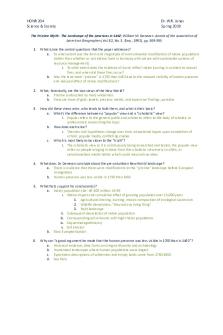Pristine Myth Questions PDF

| Title | Pristine Myth Questions |
|---|---|
| Author | Michelle Wheeler |
| Course | Honors Science and Society |
| Institution | Loyola University Chicago |
| Pages | 1 |
| File Size | 55.5 KB |
| File Type | |
| Total Downloads | 97 |
| Total Views | 127 |
Summary
Homework assignment for the Pristine Myth....
Description
HONR 204 Science & Society
Dr. W.R. Jones Spring 2019
The Pristine Myth: The Landscape of the Americas in 1492; William M. Denevan. Annals of the Association of American Geographers,Vol. 82, No. 3, (Sep., 1992), pp. 369-385 1.
What is/are the central questions that the paper addresses? a. To what extent was the form and magnitude of environmental modification of native populations (rather than whether or not Indians lived in harmony with nature with sustainable systems of resource management). i. To what extent does the evidence of burns reflect Indian burning in contrast to natural fires, and when did these fires occur? b. Was the land more “pristine” in 1750 than 1492 due to the reduced visibility of human presence and reduced effect of native modifications?
2.
What, historically, are the two views of the New World? a. Pristine (untouched by man) wilderness b. Treasure trove of gold, jewels, precious metals, and expensive findings; paradise
3.
How did these views arise, who tends to hold them, and what is their basis? a. What’s the difference between a “popular” view and a “scholastic” view? i. Popular refers to the general public and scholastic refers to the body of scholars or professionals researching the topic b. How does each arise? i. Theories and hypotheses change over time, educational lapses upon completion of school, popular media, conflicting studies c. Which is most likely to be closer to the “truth”? i. The scholastic view as it is continuously being researched and tested, the popular view relies on people bringing in ideas from the scholastic view every so often, or sensationalized media tidbits which could misconstrue ideas
4.
What does Dr. Denevan conclude about the pre-columbian New World landscape? a. There is evidence that there were modifications to the “pristine” landscape before European immigration b. Human presence was less visible in 1750 than 1492
5.
What facts support his conclusion(s)? a. Indian population size: 40-100 million, 43-65 i. Native impact and cumulative effect of growing population over 15,000 years 1. Agricultural clearing, burning, mosaic composition of ecological succession 2. Wildlife devastation, “they eat any living thing” 3. Built landscape ii. Subsequent devastation of native population iii. Corresponding ash amounts with high Indian populations iv. Sequential agroforestry v. Soil erosion b. Slow Europeanization
6.
Why can “a good argument be made that the human presence was less visible in 1750 than in 1492”? a. Historical evidence, data from surviving earthworks and archaeology b. Humanized landscapes where human populations were largest c. Eyewitness descriptions of wilderness and empty lands come from 1750-1850 d. See facts...
Similar Free PDFs

Pristine Myth Questions
- 1 Pages

Notes on Afterlife Myth
- 4 Pages

Barthes-Myth Today-excerpt
- 23 Pages

Functionsof Myth Script
- 3 Pages

Myth Paper 1
- 3 Pages

Greek Myth Syllabus
- 6 Pages

Greek myth notes
- 55 Pages

Greek myth reading response
- 1 Pages

Greek myth final
- 23 Pages

Myth Assessment Essay - Grade: A
- 4 Pages

Definitions of Myth
- 2 Pages

Myth Computer Case
- 7 Pages

THE MYTH OF ASIA\'S MIRACLE
- 12 Pages

American Dream (myth vs reality)
- 3 Pages

Creation Myth Essay - Grade: A
- 6 Pages
Popular Institutions
- Tinajero National High School - Annex
- Politeknik Caltex Riau
- Yokohama City University
- SGT University
- University of Al-Qadisiyah
- Divine Word College of Vigan
- Techniek College Rotterdam
- Universidade de Santiago
- Universiti Teknologi MARA Cawangan Johor Kampus Pasir Gudang
- Poltekkes Kemenkes Yogyakarta
- Baguio City National High School
- Colegio san marcos
- preparatoria uno
- Centro de Bachillerato Tecnológico Industrial y de Servicios No. 107
- Dalian Maritime University
- Quang Trung Secondary School
- Colegio Tecnológico en Informática
- Corporación Regional de Educación Superior
- Grupo CEDVA
- Dar Al Uloom University
- Centro de Estudios Preuniversitarios de la Universidad Nacional de Ingeniería
- 上智大学
- Aakash International School, Nuna Majara
- San Felipe Neri Catholic School
- Kang Chiao International School - New Taipei City
- Misamis Occidental National High School
- Institución Educativa Escuela Normal Juan Ladrilleros
- Kolehiyo ng Pantukan
- Batanes State College
- Instituto Continental
- Sekolah Menengah Kejuruan Kesehatan Kaltara (Tarakan)
- Colegio de La Inmaculada Concepcion - Cebu
